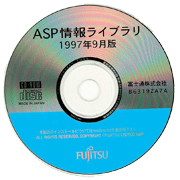ASP (which stood for “Advanced System Products”) was developed for the FUJITSU K6000 series. Replacing CSP/FX, the ASP operating system was announced in October 1992. The FUJITSU K6000 series was developed based on a concept of coexisting with open systems in a multi-vender world; ASP, as the successor to CSP/FX, was able to use CSP/FX assets without modification.
Chronologically, ASP consisted of the Enn series (E72/E92, E73/E93, E94, etc.) and the later Vnn series (V10, V11, etc.). The Enn series was suited for the FUJITSU K6000 series and the FUJITSU K6000α series, and the Vnn series was adopted for the GRANPOWER 6000 series (announced in May 1997). Within the Enn series, the E70 line of operating systems was designed for entry-level machines while the E90 line of operating systems was designed for top-end machines. The E90 line was furnished with CSP/F3 compatible program functions (development environment, execution environment, and asset migration), and because of these functions the E70 line was eventually absorbed into the E90 line after the E73 release.
The Enn series of ASP operating systems underwent a rapid succession of enhancements, beginning with E92, which shipped in December 1992, and ending with E98, which shipped in December 1996. The Vnn series was also updated frequently, from V10, which shipped in August 1997, to V15, which shipped in June 2000. The latest version as of July 2010 was the ASP/V26. This description looks at the functions of the initial operating system (E92) and touches on the main enhancements added prior to 2000.
The ASP operating system announced in October 1992 had the following characteristic functions.
- (1) Enhanced open system support, such as TCP/IP connectivity with various makes of personal computers and workstations
- Provided RDA-SV/TCP, which was compatible with the ISO remote database access (RDA) standard
RDA-SV/TCP made it possible for ISV software on a personal computer to access relational databases managed by RDB/6000 on FUJITSU K6000 series machines. - Supported the full screen mode of TELNET, a virtual terminal function
This support allowed LAN-connected personal computers and workstations (using the TCP/IP protocol) to be used as display terminals for FUJITSU K6000 series machines. - Provided LANPARTNER, a PC-LAN server function
This function provided connectivity with LAN Manager (a Microsoft product) running on a personal computer. This made it possible to work interactively between application programs that used named pipe functions, share files, and share printers. - Supported the standard multi-level file systems of MS-DOS and UNIX
- Offered fax support
- Enhanced the JOIN function for importing personal computer data formats
In addition to the previous JOIN MS-DOS function, ASP provided the new JOIN-Ichitaro, as a JOIN function that imported various data formats from a personal computer. E93 would later add the JOIN 1-2-3 and JOIN EXCEL functions. - Enhanced PCSP, a personal computer-centered communication function
PCSP stood for “Personal Computer Communication Service Program,” which provided personal-computer communication services. - (2) Improved usability through advanced software
- Increased the operating system’s basic performance levels
ASP featured shorter system boot-up times and faster sorting of large amounts of data by accelerating file opening and program loading operations. - Improved the visual performance of K-Windows screen operations and made multi-windows a standard function
K-Windows was a remote windows function for workstations first provided with CSP/FX. - Provided RDB/6000, a relational database management software that conformed to the international SQL standard
The RDB/6000 name was changed to SymfoWARE 6000 (and later to Symfoware 6000) with ASP/V13. - Provided DB-EXPRESS, a database transfer function
This function allowed RDB/6000 on FUJITSU K6000 series machines to connect to DB-EXPRESS on FUJITSU M series mainframes and extract M series databases. - Provided GMS (which stood for “Generation Management Service”, a next-generation management system that increased the maintainability of program development.
The characteristic functions above were part of ASP when it was first announced. The functions below were the main enhancements added to ASP prior to 2000 and are given roughly in chronological order.
- In an October 1993 upgrade, the FUJITSU K6000 series switched to an original Fujitsu 64-bit RISC processor. ASP was also updated to support the new processor.
- Added support for Netware and OS/2 operating systems on connected personal computers.
- The FUJITSU GRANPOWER 6000 series, announced in May 1997, used Intel processors. ASP was also updated to support these processors and the initial version was ASP/V10. Subsequent versions would follow the ASP/Vnn naming format.
- An address dictionary was provided as part of the development environment.
- Added an agent function to MpWalker (later named Systemwalker), a Fujitsu system management product.
- To support network computing, ASP provided an emulator function (Webjet) that ran on a Web server or in a browser.
- Provided LISTVIEW (later named Systemwalker ListWORKS), which converted office computer forms to digital formats, and a PDF conversion function.
- Provided a common Java development and execution environment on all Fujitsu server products.
- Provided the functionality to construct WWW-centric systems.


